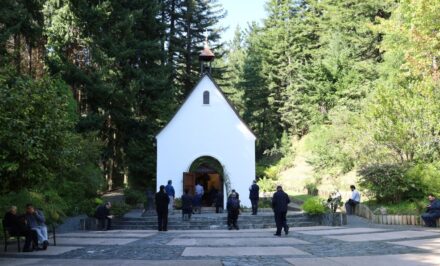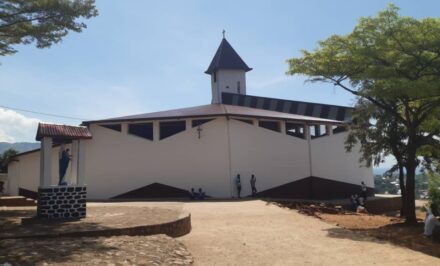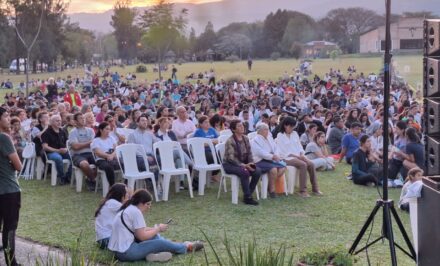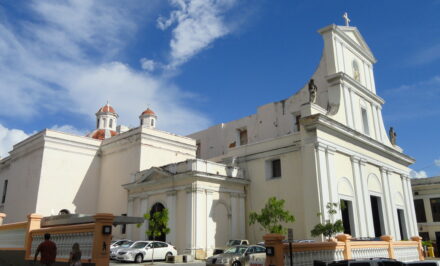 ARGENTINA, Roberto Bosco – AICA/mda. Educa, publishing house for the Argentinean Pontifical Catholic University Santa María de los Buenos Aires (UCA), has just printed and put into circulation the book “Achalay mi Virgen! María en el folklore argentino”. It was written by Olga Fernández Latour de Botas, a regular member of the Academia Argentina de Letras (Academy of Arts) and the Academia Nacional de la Historia (National Academy of History).
ARGENTINA, Roberto Bosco – AICA/mda. Educa, publishing house for the Argentinean Pontifical Catholic University Santa María de los Buenos Aires (UCA), has just printed and put into circulation the book “Achalay mi Virgen! María en el folklore argentino”. It was written by Olga Fernández Latour de Botas, a regular member of the Academia Argentina de Letras (Academy of Arts) and the Academia Nacional de la Historia (National Academy of History).
![]()
 The authoress is surely today the highest authority in Argentinia on folklore, history and philology (language and literature). This publication acknowledges her original manuscript in the doctoral thesis of the well-known and prestigious researcher and it has been possible due to a work of adaptation by Víctor Manuel Fernández, archbishop/rector of the Catholic University of Argentina.
The authoress is surely today the highest authority in Argentinia on folklore, history and philology (language and literature). This publication acknowledges her original manuscript in the doctoral thesis of the well-known and prestigious researcher and it has been possible due to a work of adaptation by Víctor Manuel Fernández, archbishop/rector of the Catholic University of Argentina.
In this work, the authoress, heiress to the unequalled labor by personalities of the stature of Juan alfonso Carrizo, Augusto Raúl Cortázar, Bruno Jacovella and Julián Cáceres Freyre. The different cultural expressions which bookmark the Virgin Mary in the religiosity of the Christian people in the Argentinean scene pass through a meticulous inspection.
After an introduction to folklore sciences, Fernández Latour sets her research on the local background and in continuation refers to the Spanish Marian legacy. The evangelization of America constituted an epic with a clearly Marian mark as the name confirms not only with the first caravel carrying the discoverer, the Santa María, but of the innumerable geographic accidents and in particular the cities, including among the most Argentinean ones which refer to Nuestra Señora del Buen Aire [Our Lady of Good Air] (patroness of navigators) or to the Virgin of the Rosary.
The Marian advocations are found multiplied on the national soil. Beginning with that of Our Lady of Luján, patroness of Argentina.
Popular religiosity, a true protective treasure against the philosophy of materialism and the standardization of secularism
 After overcoming a certain critical attitude which rested on local theology in the years after the Second Vatican Council, popular religiosity is valued today in all its richness and this is as it is largely due to the so-called Theology of the People. This current emerged in the 1960’s with a trait of autonomy and representative of an original vision pertaining to evangelization. This aspect is characterized by a theology incarnate in history which takes into consideration the cultural realities of each community as real subject and original of the Christian life.
After overcoming a certain critical attitude which rested on local theology in the years after the Second Vatican Council, popular religiosity is valued today in all its richness and this is as it is largely due to the so-called Theology of the People. This current emerged in the 1960’s with a trait of autonomy and representative of an original vision pertaining to evangelization. This aspect is characterized by a theology incarnate in history which takes into consideration the cultural realities of each community as real subject and original of the Christian life.
The documents of the Latin American episcopate like that of the Conference of Aparecida (Brazil) in 2007 have contributed for seeing in popular religiosity a true protective treasure against the philosophy of materialism and standardization of secularism, and Pope Francis has become a repeating echo of this living reality.
Fernández Latour gathers an enormous variety of cultural expressions representative of the presence of Mary in popular Argentinean culture, including dances and native dances (the authoress possesses basic information in this discipline) and finalizes studying Marian tradition in diverse poetic-musical genres, including texts by María Elena Walsh and Félix Luna.
Many faithful Catholics ignore that this distinguised Argentinean historian is the author of canticles with the popular savor which they themselves sing as part of the liturgy. Pope Francis will attend at the Holy See and next Christmas a representation of the Creole Mass, one of the expressions most known from the inculturation of the faith in the Republic of Argentina, now distinguished with local characters in the great stage of the universal Church.
The power of popular faith
 “Dilexit ecclesiam: Because we love the Church, we are interested in her, we get involved and we allow ourselves to be inspired and questioned by her,” thus Fr. José María García from the schoenstatt.org press office introduced the new category of news: Dilexit Ecclesiam, in which this news from AICA was published. Reading the book, immediately come to mind the thousands of Way Side Shrines of the Blessed Mother scattered along the roads of Argentina, from north to south, from east to west. Also comes to mind the thousands of thousands of Pilgrim MTA’s in the hands of coordinators who dare to reach areas where others fear to go. The power of popular faith, the warmth of the Marian devotion of the Argentinean people (and not only of it) is demonstrated in the Rosary Campaign of the Pilgrim Virgin. It was not always welcomed in Schoenstatt. Much too simple, much too popular, creating trouble, in the best sense of Bergogliano words, it has often run the risk of being “domesticated” and transformed into part of the organized Schoenstatt. Nevertheless, from early on, it was a desire of Father Kentenich who already in 1934 summoned to form a great popular movement of pilgrims in his Schoenstatt. A desire which was completely fulfilled in the Campaign of the poor pilgrim, Joao Pozzobon.
“Dilexit ecclesiam: Because we love the Church, we are interested in her, we get involved and we allow ourselves to be inspired and questioned by her,” thus Fr. José María García from the schoenstatt.org press office introduced the new category of news: Dilexit Ecclesiam, in which this news from AICA was published. Reading the book, immediately come to mind the thousands of Way Side Shrines of the Blessed Mother scattered along the roads of Argentina, from north to south, from east to west. Also comes to mind the thousands of thousands of Pilgrim MTA’s in the hands of coordinators who dare to reach areas where others fear to go. The power of popular faith, the warmth of the Marian devotion of the Argentinean people (and not only of it) is demonstrated in the Rosary Campaign of the Pilgrim Virgin. It was not always welcomed in Schoenstatt. Much too simple, much too popular, creating trouble, in the best sense of Bergogliano words, it has often run the risk of being “domesticated” and transformed into part of the organized Schoenstatt. Nevertheless, from early on, it was a desire of Father Kentenich who already in 1934 summoned to form a great popular movement of pilgrims in his Schoenstatt. A desire which was completely fulfilled in the Campaign of the poor pilgrim, Joao Pozzobon.
In 1977, Fr. Alex Menningen resumed the the thought of the Founder in this way: “The people will save Schoenstatt from elitism and the monopoly mentality which always threaten the Church and each one of its Movements.” – “Without the Popular Movement of Pilgrims, Schoenstatt is in grave danger of falling, because of original and personal sin, and distortions and deformities.”
Original: Spanish. Translation: Carlos Cantú, Schoenstatt Family Federation, La Feria, Texas USA 10022014













